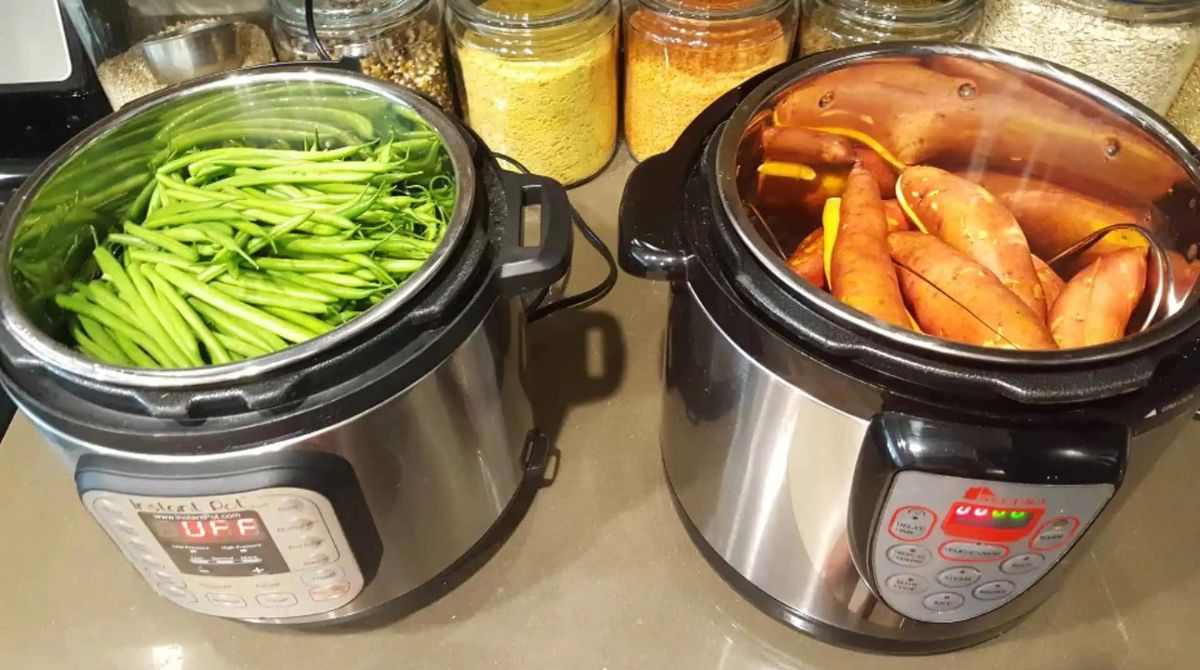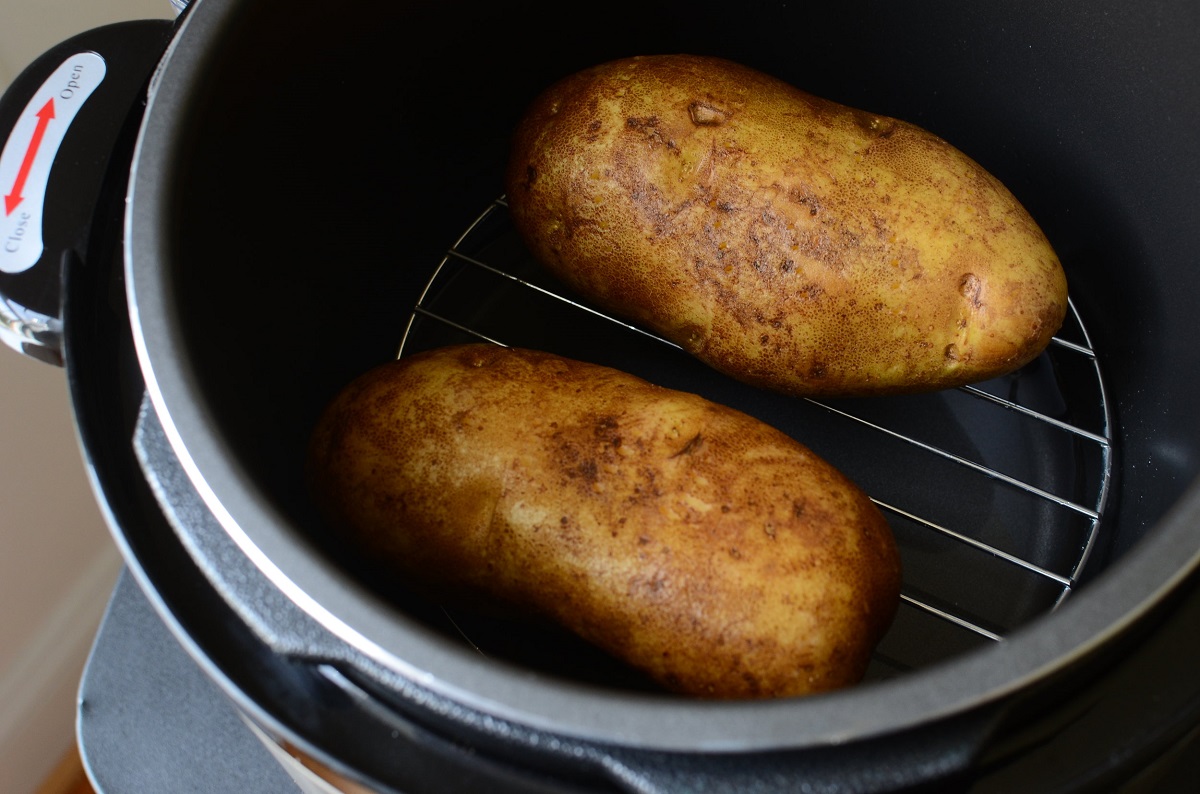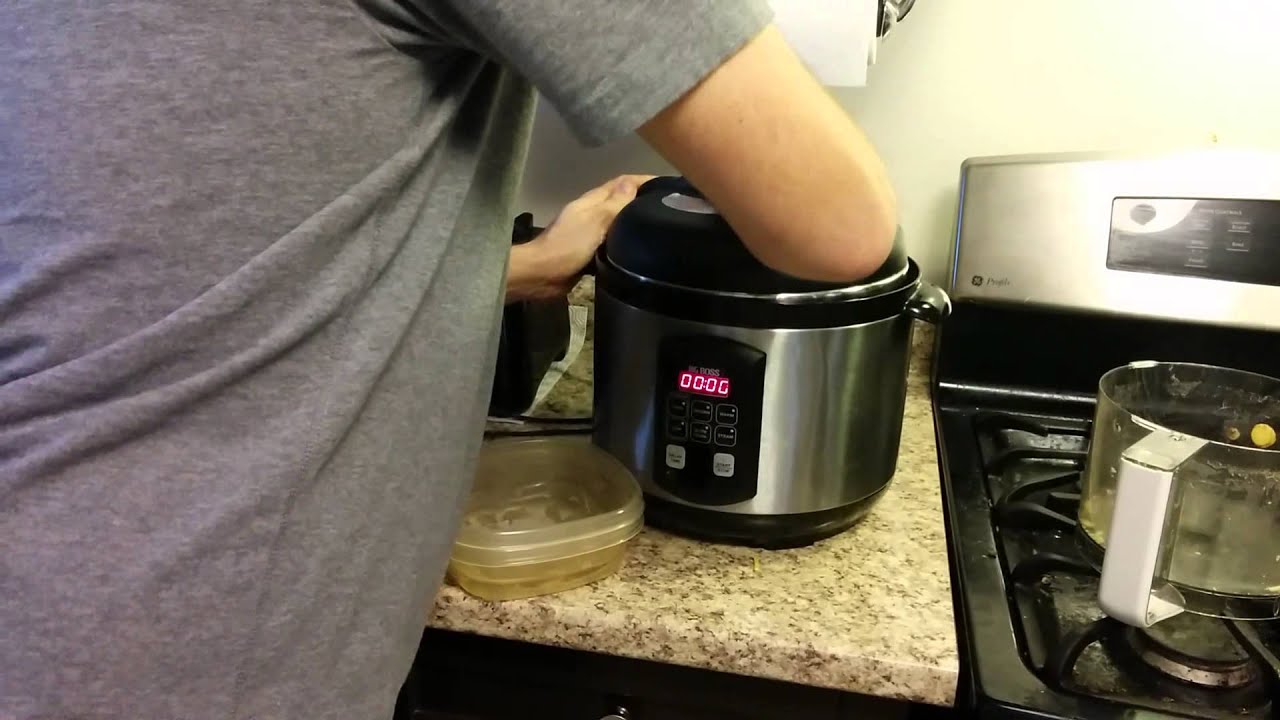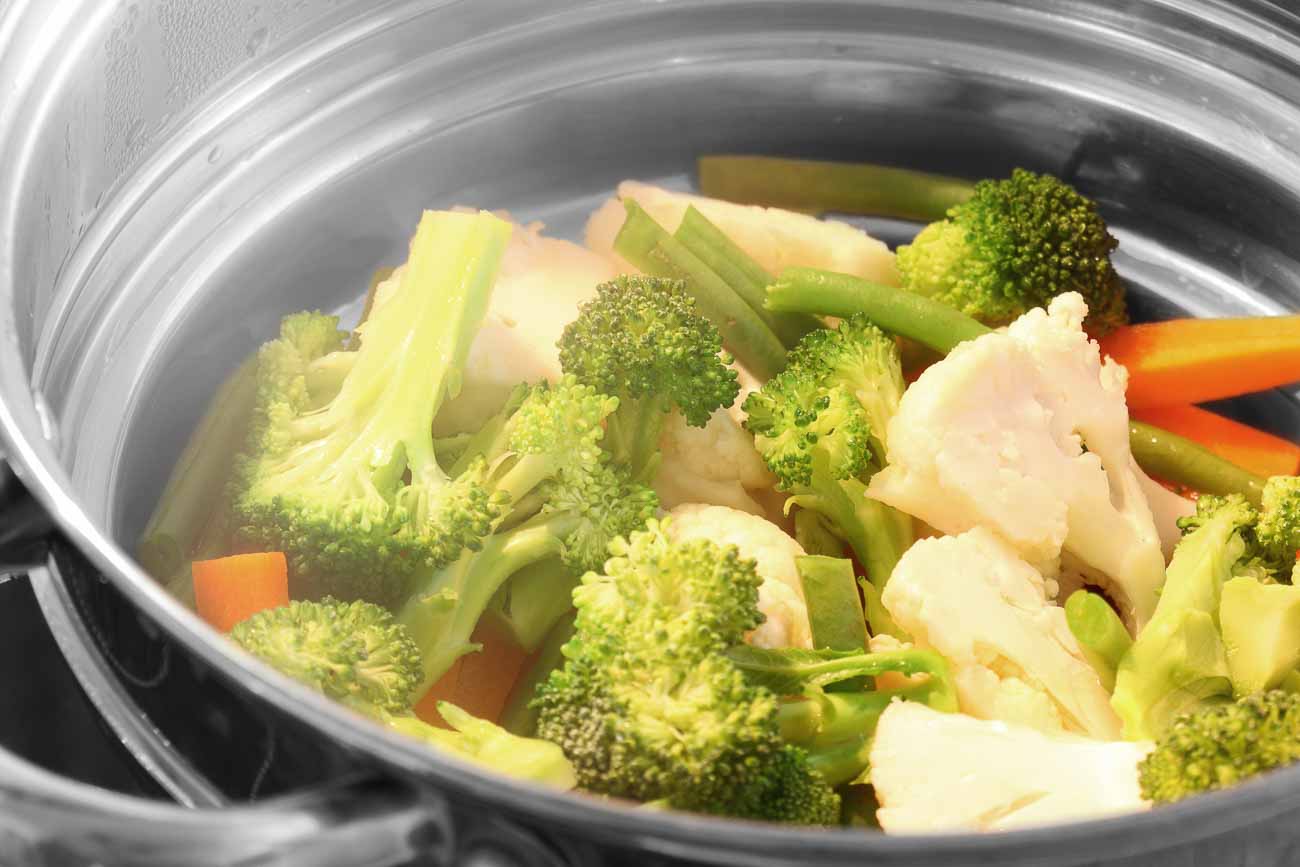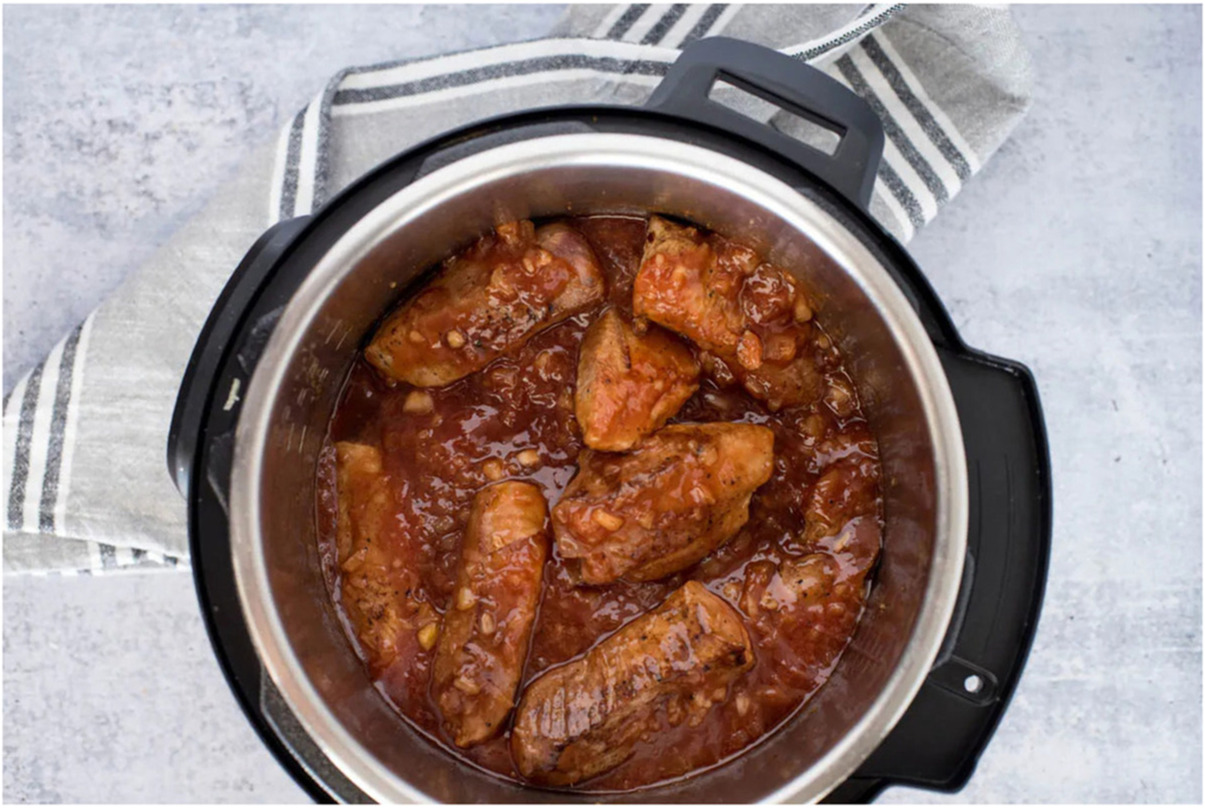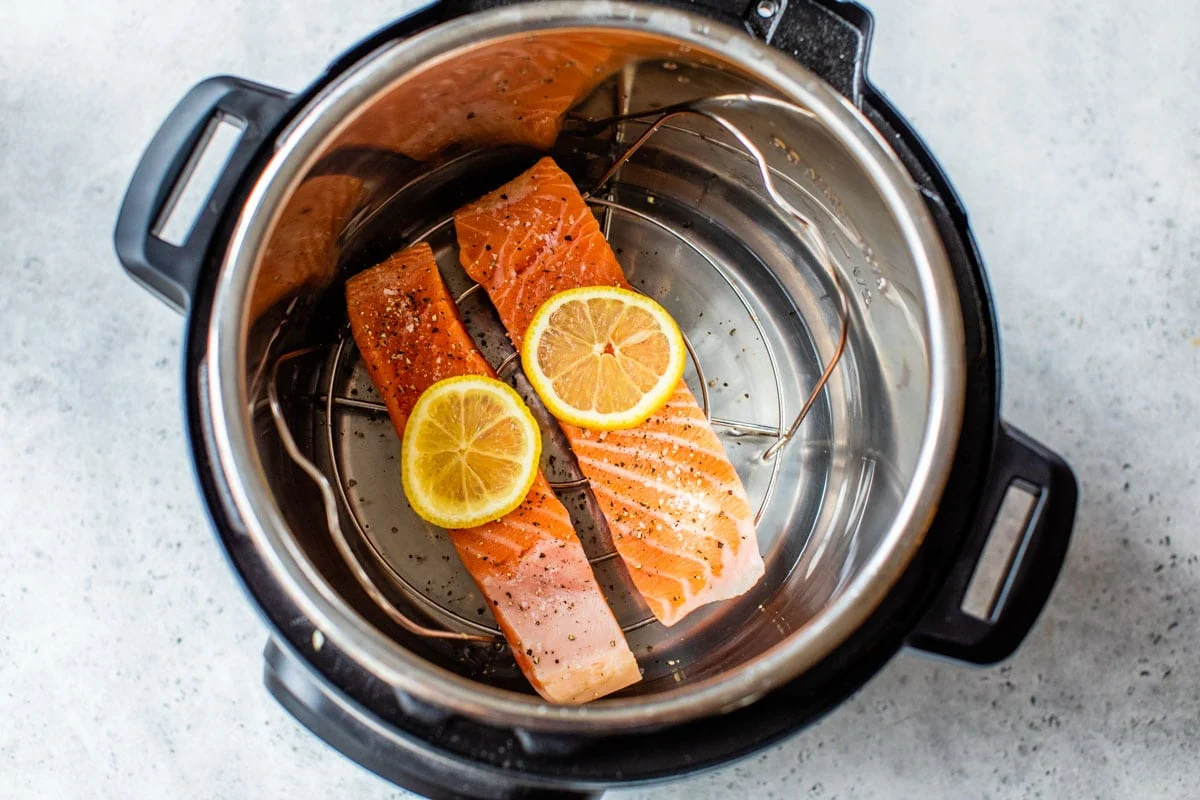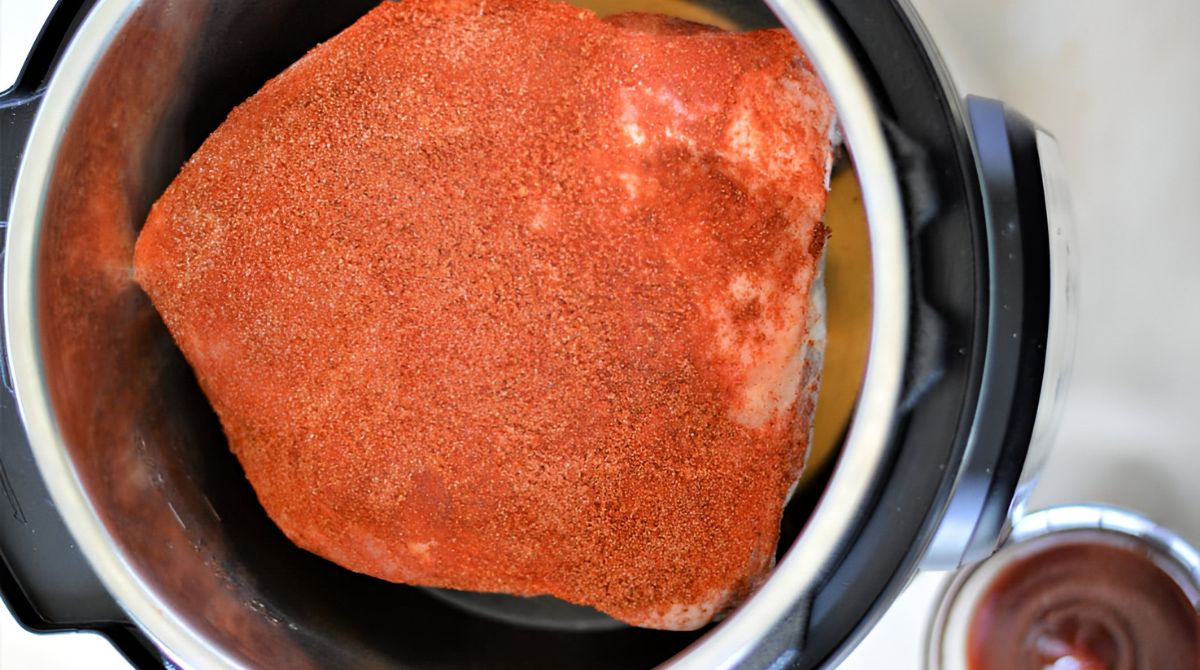Introduction
Welcome to the world of cooking with electric pressure cookers! These handy kitchen appliances have gained popularity in recent years for their ability to quickly and efficiently cook a variety of foods, including sweet potatoes. If you’re looking to whip up delicious and tender sweet potatoes without spending hours in the kitchen, an electric pressure cooker is the way to go.
Sweet potatoes are not only tasty, but they also offer a range of health benefits. Packed with vitamins, minerals, and antioxidants, sweet potatoes provide a nutritious addition to any meal. By using an electric pressure cooker, you can retain the natural flavors and nutrients of sweet potatoes, while reducing the cooking time significantly.
In this article, we will guide you through the process of cooking sweet potatoes in an electric pressure cooker. Whether you’re a seasoned cook or a beginner in the kitchen, you’ll find these steps easy to follow. We’ll also provide some useful tips and variations to help you customize your sweet potato dishes according to your preferences.
Before we dive into the cooking process, it’s essential to understand the safety precautions associated with using an electric pressure cooker. These appliances operate under high pressure, so it’s crucial to read and follow the manufacturer’s instructions carefully. By following the guidelines and practicing caution, you can safely enjoy the convenience of cooking sweet potatoes in an electric pressure cooker.
So, if you’re ready to elevate your sweet potato cooking game and save time in the kitchen, let’s get started with this step-by-step guide!
Benefits of Cooking Sweet Potatoes in an Electric Pressure Cooker
Cooking sweet potatoes in an electric pressure cooker offers several advantages that make it a fantastic cooking method. Here are some of the key benefits:
- Faster Cooking Time: One of the significant advantages of using an electric pressure cooker is the reduced cooking time. Sweet potatoes typically take a long time to cook using conventional methods such as boiling or baking. However, an electric pressure cooker can significantly cut down the cooking time, allowing you to enjoy tender and flavorful sweet potatoes in a fraction of the time.
- Retained Nutrients: The high-pressure environment created by an electric pressure cooker helps retain the nutrients present in sweet potatoes. Compared to boiling, which can lead to nutrient loss due to water-soluble vitamins leaching into the cooking water, pressure cooking helps preserve the nutritional value of the sweet potatoes. This means you can indulge in a nutrient-dense meal without compromising on taste and texture.
- Enhanced Flavor: Cooking sweet potatoes under pressure helps intensify their natural flavors. The sealed environment prevents the flavors from escaping, resulting in a more concentrated and delicious taste. The tender and creamy texture of pressure-cooked sweet potatoes also adds to their overall appeal. Whether you’re enjoying them on their own or using them in recipes, the flavor profile of pressure-cooked sweet potatoes is sure to impress.
- Ease of Preparation: Using an electric pressure cooker to cook sweet potatoes is incredibly easy and convenient. Once you’ve prepped the sweet potatoes, you simply need to set the cooking time and let the pressure cooker do its magic. There’s no need to worry about stirring, monitoring the temperature, or adjusting the heat. The pressure cooker takes care of everything, allowing you to multitask or relax while your sweet potatoes cook to perfection.
- Versatility: Electric pressure cookers are incredibly versatile appliances. In addition to cooking sweet potatoes, you can use them to prepare a wide range of dishes, from soups and stews to rice and risottos. This versatility makes the electric pressure cooker a valuable tool in any kitchen, allowing you to explore various culinary possibilities while efficiently cooking your favorite sweet potato recipes.
Considering these benefits, it’s no wonder that more and more people are turning to electric pressure cookers for their sweet potato cooking needs. Now that we’ve explored the advantages, let’s move on to the next section, where we’ll discuss the safety precautions to keep in mind when using an electric pressure cooker to cook sweet potatoes.
Safety Precautions
While cooking sweet potatoes in an electric pressure cooker offers many benefits, it is essential to prioritize safety when using this kitchen appliance. Here are some important safety precautions to keep in mind:
- Read the Manual: Before using your electric pressure cooker, carefully read the instruction manual provided by the manufacturer. Familiarize yourself with the specific features, functions, and safety guidelines unique to your pressure cooker model.
- Check for Damage: Before each use, inspect your electric pressure cooker for any signs of damage or wear. Look for things like cracks, loose parts, or a malfunctioning lid. If you notice any issues, do not use the cooker until it has been repaired or replaced.
- Proper Venting: Ensure that the pressure release valve and the sealing ring are clean, properly installed, and in good condition. This will help maintain the appropriate pressure and prevent potential accidents.
- Enough Liquid: Always ensure there is enough cooking liquid in the pressure cooker when cooking sweet potatoes or any other foods. The liquid is necessary to create steam and maintain the pressure inside the cooker. Not having enough liquid can cause the cooker to overheat or fail to reach the required pressure.
- Handle with Care: The electric pressure cooker becomes extremely hot during the cooking process. Use oven mitts or other heat-resistant gloves when handling the cooker or removing the lid after cooking. Avoid touching any part of the cooker without protection to prevent burns.
- Release Pressure Safely: When the cooking time is complete, follow the recommended method for releasing the pressure inside the cooker. There are two common methods: natural release and quick release. Natural release allows the pressure to drop naturally over time, while quick release rapidly releases the pressure using the release valve. Always consult your pressure cooker’s manual for the proper release method for your specific model.
- Careful Lid Opening: Before opening the lid, make sure all the pressure has been released from the cooker. This can be checked by testing the pressure release valve or using the float valve (if applicable). Opening the lid while there is still pressure inside can lead to hot steam burns.
- Clean and Maintain Regularly: Regularly clean and maintain your electric pressure cooker according to the manufacturer’s instructions. This includes cleaning the cooking pot, lid, sealing ring, and other removable parts. Proper maintenance ensures the cooker operates safely and efficiently for future cooking endeavors.
By following these safety precautions, you can use your electric pressure cooker confidently and enjoy the benefits of cooking sweet potatoes without any unnecessary risks or accidents. With safety covered, let’s move on to the next section, where we’ll delve into the first step: choosing the right sweet potatoes.
Step 1: Choosing the Right Sweet Potatoes
Choosing the right sweet potatoes is an essential first step when it comes to preparing a delicious dish in your electric pressure cooker. Here are some tips to help you select the best sweet potatoes:
- Freshness: Look for sweet potatoes that are firm and free from any soft spots or blemishes. Fresh sweet potatoes will have smooth skin without any wrinkles or shriveling.
- Size and Shape: When it comes to size, choose sweet potatoes that are similar in size. This will ensure even cooking. As for shape, opt for sweet potatoes that are uniform and have a straight, cylindrical shape. This will make it easier to cut them into evenly sized pieces if necessary.
- Skin Color: Sweet potatoes come in a variety of colors, including orange, red, purple, and white. The color of the skin is a matter of personal preference, as it doesn’t significantly affect the taste or texture. Select the color that appeals to you, keeping in mind that different colors may have slightly different flavor profiles.
- Vibrancy: Look for sweet potatoes with vibrant and richly colored skin. Deep and intense colors are an indication of their nutritional value and can also enhance the visual appeal of your cooked dish.
- Organic vs. Conventional: If organic produce is important to you, opt for organic sweet potatoes. They are grown without synthetic pesticides and fertilizers, making them a more environmentally friendly choice. However, conventional sweet potatoes can still be a healthy option if organic is not readily available or within your budget.
- Local and Seasonal: Whenever possible, choose sweet potatoes that are locally grown and in-season. Local sweet potatoes are often fresher and have a smaller carbon footprint as they don’t require long-distance transportation. Additionally, seasonal sweet potatoes tend to be tastier and more affordable.
Keep these tips in mind when selecting your sweet potatoes for cooking in the electric pressure cooker. Once you have chosen the perfect sweet potatoes, it’s time to move on to the next step: cleaning and prepping them for cooking.
Step 2: Cleaning and Prepping Sweet Potatoes
After selecting the right sweet potatoes, it’s essential to properly clean and prep them before cooking in the electric pressure cooker. Follow these steps to ensure your sweet potatoes are ready to be cooked:
- Wash Thoroughly: Start by giving your sweet potatoes a good wash under running water. Use a vegetable brush to scrub away any dirt or debris from the skin. This step is crucial, especially if you are not peeling the sweet potatoes, as it helps remove any impurities from the outer surface.
- Peeling (Optional): Depending on your preference and the recipe you’re following, you may choose to peel the sweet potatoes. Peeling them will result in a smoother texture. Use a vegetable peeler or a sharp knife to carefully remove the skin. Alternatively, you can leave the skin on for added nutrients and a bit of texture.
- Trimming: Check the sweet potatoes for any rough or damaged spots. If you come across any bruises or blemishes, use a knife to trim away the affected areas. This step will ensure you’re working with fresh and healthy sweet potatoes.
- Cutting: If your recipe calls for cut sweet potatoes, it’s time to dice them into evenly sized pieces. This will ensure that they cook evenly in the electric pressure cooker. Use a sharp knife and a sturdy cutting board to cut the sweet potatoes into cubes, wedges, or slices, depending on your preference.
- Alternatively, Leaving Whole: Whole sweet potatoes can also be cooked in the electric pressure cooker. In this case, you can skip the cutting step and leave the sweet potatoes whole. This method works well if you plan on using the sweet potatoes as a side dish or for mashing.
Once you have cleaned and prepped your sweet potatoes, they are ready to be cooked in the electric pressure cooker. In the next section, we will guide you through the process of setting up the electric pressure cooker for cooking the sweet potatoes.
Step 3: Setting Up the Electric Pressure Cooker
Before you start cooking your sweet potatoes in the electric pressure cooker, it’s important to set it up correctly. Follow these steps to ensure you have everything ready:
- Read the Manual: Familiarize yourself with the specific features and functions of your electric pressure cooker by reading the instruction manual. Each model may have slightly different settings and buttons, so understanding your specific cooker is crucial for successful cooking.
- Insert the Cooking Pot: Place the cooking pot into the electric pressure cooker base. Ensure that it is properly seated and secure.
- Add Liquid: Most sweet potato recipes in the electric pressure cooker require a small amount of liquid to create steam and build pressure. Check your recipe for the amount of liquid needed, such as water, broth, or a combination of both. Pour the specified amount of liquid into the cooking pot.
- Arrange the Sweet Potatoes: Carefully place the cleaned and prepped sweet potatoes into the cooking pot. If you cut them into pieces, arrange them in a single layer, ensuring they are not stacked on top of each other. This will promote even cooking and prevent them from sticking together.
- Check the Seal: Ensure that the sealing ring is securely in place on the lid. The sealing ring is responsible for creating an airtight seal during cooking.
- Attach the Lid: Firmly place the lid on the electric pressure cooker, ensuring that it is properly aligned and seated. Depending on your model, it may either twist and lock or simply rest on top.
- Secure the Lid: Some electric pressure cookers have a locking mechanism to secure the lid in place. Follow the manufacturer’s instructions to lock the lid properly for cooking.
- Check the Pressure Release Valve: Ensure that the pressure release valve is set to the appropriate position. For cooking sweet potatoes, the valve is usually set to the sealing position to build pressure inside the cooker.
- Plug in and Power On: Insert the power cord into an electrical outlet and power on your electric pressure cooker. The display panel should light up, indicating that the cooker is ready for use.
- Select the Cooking Time and Pressure Level: Depending on your recipe, choose the cooking time and pressure level on the control panel of your electric pressure cooker. Follow the instructions provided in your recipe or consult the cooking time guidelines for sweet potatoes. Typically, sweet potatoes cook well under high pressure for 5-10 minutes.
With the electric pressure cooker set up correctly, you are now ready to cook your sweet potatoes to perfection. In the next section, we’ll guide you through the cooking process step by step.
Step 4: Cooking Sweet Potatoes in the Electric Pressure Cooker
Now that your electric pressure cooker is set up and ready, it’s time to start cooking your sweet potatoes. Follow these steps to ensure perfectly cooked sweet potatoes every time:
- Close and Lock the Lid: Once you have selected the cooking time and pressure level, close the lid of the electric pressure cooker and lock it into place. Ensure that the pressure release valve is in the sealing position.
- Start the Cooking Process: Depending on your electric pressure cooker model, you may need to press a button or select a specific cooking program to start the cooking process. Follow the instructions provided in your cooker’s manual to initiate the cooking cycle.
- Build Up Pressure: The electric pressure cooker will now heat up and start building pressure inside the pot. You will notice steam escaping from the pressure release valve. Once the desired pressure level is reached, the valve will close, and the cooking time will begin.
- Cooking Time: Let the sweet potatoes cook for the specified time, typically around 5-10 minutes under high pressure. The cooking time may vary depending on the size and thickness of the sweet potato pieces. Avoid opening the lid during the cooking process, as it will release the pressure and interrupt the cooking cycle.
- Countdown Timer: Your electric pressure cooker will have a built-in countdown timer that displays the remaining cooking time. Use this timer as a guide, but keep in mind that the actual cooking time may vary slightly based on factors such as the starting temperature of the sweet potatoes and variations in individual cooker models.
- Automatic Keep Warm: Once the cooking time is complete, many electric pressure cookers have an automatic keep warm function. This feature will switch on automatically, keeping your sweet potatoes warm until you’re ready to release the pressure and serve them.
Cooking sweet potatoes in an electric pressure cooker is an efficient and time-saving method. The sealed environment ensures that the flavors and nutrients are retained, resulting in tender and delicious sweet potatoes. In the next step, we’ll explore the different pressure release methods and their impact on the cooking process.
Step 5: Natural Release vs. Quick Release
After the cooking time for your sweet potatoes is complete, you have two options for releasing the pressure in your electric pressure cooker: natural release and quick release. Each method has its advantages and is suitable for different cooking scenarios.
Natural Release: Natural release involves letting the pressure inside the cooker release naturally over time. After the cooking time is complete, simply leave the pressure cooker undisturbed and allow the pressure to drop on its own. This process can take anywhere from 10 to 20 minutes or even longer, depending on the amount of pressure built up in the cooker.
Natural release is ideal for dishes that require a longer cooking time, such as stews or meat recipes, as it allows for additional tenderization of the ingredients. It is also recommended for foods with a high starch content, such as sweet potatoes, as it helps prevent the food from becoming mushy. Natural release is a gentle and gradual method of depressurizing the cooker, ensuring that the sweet potatoes retain their shape and texture.
Quick Release: Quick release involves manually releasing the pressure inside the electric pressure cooker immediately after the cooking time is complete. To perform a quick release, carefully move the pressure release valve from the sealing to the venting position using a long utensil or a towel to avoid your hand being exposed to the steam.
This method is particularly useful when you need to stop the cooking process quickly, or when you’re working with delicate ingredients that can overcook easily, such as vegetables or seafood. Quick release allows you to rapidly depressurize the cooker, which can help preserve the natural colors and textures of the sweet potatoes.
It’s important to note that when using the quick release method, hot steam will rapidly escape from the pressure release valve. To prevent any accidents, ensure that you keep your hands and face away from the valve during the release process.
Whether you choose natural release or quick release, both methods are effective for cooking sweet potatoes in an electric pressure cooker. Consider the specific recipe requirements and your preference for texture when deciding which method to use.
In the next step, we’ll discuss how to check the sweet potatoes for doneness before serving.
Step 6: Checking the Sweet Potatoes for Doneness
Before serving your sweet potatoes cooked in the electric pressure cooker, it’s important to check for doneness to ensure they are cooked to your desired level of tenderness. Here’s how you can check if the sweet potatoes are ready:
- Poke with a Fork: Take a fork and gently insert it into one of the sweet potato pieces. If the fork slides in easily and the sweet potato feels tender, it is likely cooked through. The texture should be soft and creamy, but not mushy.
- Check for Resistance: When you pierce a cooked sweet potato with a fork or knife, it should meet minimal resistance. If there is still a hard or slightly raw texture in the center, the sweet potatoes need more cooking time. In this case, place the lid back on the pressure cooker and cook for an additional few minutes.
- Color and Texture: Sweet potatoes cooked in an electric pressure cooker should have a vibrant color and a consistent, smooth texture. The cooked flesh should be easy to mash or cut into, without any overly dense or undercooked areas.
Keep in mind that the cooking time can vary depending on the size and thickness of the sweet potato pieces, as well as the pressure level and the specific model of your electric pressure cooker. If you find that the sweet potatoes are not yet done, simply reseal the cooker and continue cooking for a few more minutes until the desired level of tenderness is achieved.
Once the sweet potatoes are cooked to your liking, it’s time to carefully remove them from the electric pressure cooker and serve them in your favorite way. In the next step, we’ll explore some serving suggestions and ways to enjoy your perfectly cooked sweet potatoes.
Step 7: Serving and Enjoying Your Sweet Potatoes
Now that your sweet potatoes are cooked to perfection in the electric pressure cooker, it’s time to serve and savor their deliciousness. Here are some serving suggestions and ways to enjoy your sweet potatoes:
- As a Side Dish: Serve the sweet potatoes as a simple and nutritious side dish. You can sprinkle them with a pinch of salt, a drizzle of olive oil, and a sprinkle of your favorite herbs or spices like cinnamon, paprika, or thyme. The natural sweetness of the sweet potatoes pairs well with these seasonings.
- Mashed Sweet Potatoes: Mash the cooked sweet potatoes with a fork or a potato masher for a creamy and comforting side dish. Add a pat of butter, a splash of milk or cream, and seasonings like nutmeg or brown sugar for extra flavor. Mashed sweet potatoes make a great complement to roasted meats or as a base for shepherd’s pie.
- Roasted or Grilled: For a bit of extra flavor and texture, place the cooked sweet potato pieces on a baking sheet and roast them in the oven for a few minutes until they develop a crispy exterior. You can also grill them for a smoky and charred taste. Roasted or grilled sweet potatoes make a tasty addition to salads or as a standalone dish alongside grilled meats or veggies.
- Sweet Potato Fries: Cut the cooked sweet potatoes into thin strips or wedges and bake them in the oven until they turn crispy on the outside. Season them with salt, pepper, and your choice of spices. Sweet potato fries can be enjoyed as a healthier alternative to regular fries or as a tasty snack on their own.
- In Soups or Stews: Add the cooked sweet potatoes to your favorite soups or stews for an extra touch of sweetness and creaminess. They work well in both hearty vegetable soups and spicy chili recipes, adding depth of flavor and nutritional value.
- Desserts: Sweet potatoes can also be used as a key ingredient in desserts like pies, puddings, or even brownies. Their natural sweetness and creamy texture lend themselves well to sweet treats. Explore recipes that incorporate mashed or pureed sweet potatoes to indulge in a unique and delightful dessert experience.
Experiment with these serving ideas and feel free to get creative with your sweet potato dishes. Whether you prefer them savory or sweet, the electric pressure cooker has made the cooking process effortless, allowing you to enjoy tender and flavorful sweet potatoes in no time.
With these serving suggestions in mind, you can now savor the fruits of your labor and relish the delectable flavors of your perfectly cooked sweet potatoes. Enjoy!
Additional Tips and Variations
Now that you’ve mastered the essential steps for cooking sweet potatoes in an electric pressure cooker, here are some additional tips and variations to help you elevate your sweet potato dishes:
- Seasonings and Spices: Experiment with different seasonings and spices to enhance the flavors of your sweet potatoes. Try options like cinnamon, nutmeg, rosemary, cumin, or chili powder. The right combination of spices can add depth and complexity to your dishes.
- Sweet or Savory: Determine whether you want to take a sweet or savory route with your sweet potato dishes. For a sweet twist, consider adding a sprinkle of brown sugar, maple syrup, or honey. If you prefer a savory profile, try incorporating ingredients like garlic, herbs, or even a dash of hot sauce.
- Texture Preferences: Adjust the cooking time and pressure level to achieve your desired texture. For firmer sweet potatoes, reduce the cooking time slightly, while for a softer and more melt-in-your-mouth consistency, increase the cooking time. Tailor the cooking process to your personal preference.
- Additions and Mix-ins: Get creative with your sweet potato dishes by adding complementary ingredients. Mix in cooked bacon, shredded cheese, caramelized onions, or chopped nuts like pecans or walnuts. These additions can elevate the flavor and texture profile of your sweet potatoes.
- Freezing: If you have leftovers or want to bulk cook sweet potatoes, they can be easily frozen. Allow the cooked sweet potatoes to cool completely, then transfer them to an airtight container or freezer bag. Label and date the container, and they can be stored in the freezer for up to three months. Thaw the frozen sweet potatoes in the refrigerator before reheating or using in recipes.
- Recipe Adaptations: Apply the techniques learned in this guide to adapt your favorite sweet potato recipes for the electric pressure cooker. You may need to adjust the cooking time and liquid amount accordingly. Experiment with your go-to sweet potato dishes and discover new flavors and efficiencies.
- Pairings: Sweet potatoes are incredibly versatile and can be paired with a wide range of ingredients. Consider serving them alongside roasted poultry, grilled fish, or as a filling for tacos or burritos. The natural sweetness of the sweet potatoes provides a delightful contrast to savory and tangy flavors.
- Customize Your Toppings: Go beyond the traditional toppings and customize your sweet potato dish with a variety of garnishes. Try adding a dollop of sour cream, a drizzle of balsamic glaze, or a sprinkle of green onions or cilantro to add texture and freshness.
With these additional tips and variations, you can continue to explore the versatility of sweet potatoes and craft delightful dishes that suit your taste preferences. The electric pressure cooker provides a convenient and efficient method for cooking sweet potatoes, allowing you to enjoy their flavors and nutritional benefits with ease.
Now that you’re armed with these tips and variations, it’s time to unleash your creativity in the kitchen and elevate your sweet potato game. Enjoy experimenting and discovering new delicious ways to enjoy your favorite tuber!
Conclusion
Mastering the art of cooking sweet potatoes in an electric pressure cooker opens up a world of culinary possibilities. The benefits of using this kitchen appliance, such as faster cooking times, retained nutrients, enhanced flavors, and convenience, make it an excellent choice for preparing tender and delicious sweet potatoes. By following the step-by-step guide outlined in this article, you can confidently cook sweet potatoes to perfection.
From selecting the right sweet potatoes to cleaning and prepping them, setting up the electric pressure cooker, and cooking the sweet potatoes, each step is crucial in achieving the desired results. Understanding the various pressure release methods and checking for doneness ensures that your sweet potatoes are cooked just the way you like them.
Additionally, the additional tips and variations provided offer opportunities to personalize your sweet potato dishes based on your taste preferences. Whether you choose to serve them as a side dish, mash them, roast or grill them, or even use them in desserts, sweet potatoes prepared in an electric pressure cooker are versatile and offer a range of flavor profiles.
So, take your newfound knowledge, get creative in the kitchen, and enjoy the delicious rewards of cooking sweet potatoes in an electric pressure cooker. Whether you’re a seasoned cook or a beginner, these techniques will elevate your cooking and allow you to prepare mouthwatering sweet potato dishes with ease. Embrace the convenience, savor the flavors, and make sweet potatoes a star ingredient in your meals.









